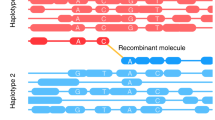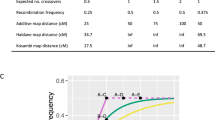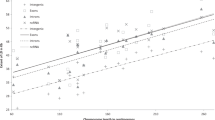Abstract
A comprehensive gene-based map of a genome is a powerful tool for genetic studies and is especially useful for the positional cloning and positional candidate approaches. The availability of gene maps for multiple organisms provides the foundation for detailed conserved-orthology maps showing the correspondence between conserved genomic segments. These maps make it possible to use cross-species information in gene hunts and shed light on the evolutionary forces that shape the genome. Here we report a radiation hybrid map of mouse genes, a combined project of the Whitehead Institute/Massachusetts Institute of Technology Center for Genome Research, the Medical Research Council UK Mouse Genome Centre, and the National Center for Biotechnology Information. The map contains 11,109 genes, screened against the T31 RH panel1 and positioned relative to a reference map containing 2,280 mouse genetic markers2. It includes 3,658 genes homologous to the human genome sequence3 and provides a framework for overlaying the human genome sequence to the mouse and for sequencing the mouse genome.
This is a preview of subscription content, access via your institution
Access options
Subscribe to this journal
Receive 12 print issues and online access
$209.00 per year
only $17.42 per issue
Buy this article
- Purchase on Springer Link
- Instant access to full article PDF
Prices may be subject to local taxes which are calculated during checkout


Similar content being viewed by others
References
McCarthy, L.C. et al. A first-generation whole-genome radiation hybrid map spanning the mouse genome. Genome Res. 7, 1153–1161 (1997).
Van Etten, W.J. et al. Radiation hybrid map of the mouse genome. Nature Genet. 22, 384–387 (1999).
International Human Genome Sequencing Consortium. Initial sequencing and analysis of the human genome. Nature 409, 860–921 (2001).
Hudson, T.J. et al. An STS-based map of the human genome. Science 270, 1945–1954 (1995).
Schuler, G.D. et al. A gene map of the human genome. Science 274, 540–546 (1996).
Deloukas, P.A. et al. Physical map of 30,000 human genes. Science 282, 744–746 (1998).
Ko, M.S. et al. Large-scale cDNA analysis reveals phased gene expression patterns during preimplantation mouse development. Development 127, 1737–1749 (2000).
Ko, M.S. et al. Genome-wide mapping of unselected transcripts from extraembryonic tissue of 7.5-day mouse embryos reveals enrichment in the t-complex and under-representation on the X chromosome. Hum. Mol. Genet. 7,1967–1978 (1998).
Chen, X., Levine, L. & Kwok, P.Y. Fluorescence polarization in homogeneous nucleic acid analysis. Genome Res. 9, 492–498 (1999).
Ewing, B. & Green, P. Analysis of expressed sequence tags indicates 35,000 human genes. Nature Genet. 25, 232–234 (2000).
Marra, M. et al. An encylopedia of mouse genes. Nature Genet. 21, 191–194 (1999).
Flury, B. A First Course in Multivariate Statistics. 656–659 (Springer, New York, 1997).
Arkell, R.M. et al. Genetic, physical and phenotypic characterisation of the Del (13) Svea36H mouse. Mamm. Genome 12, 687–694 (2001).
Dietrich, W.F. et al. A comprehensive genetic map of the mouse genome. Nature 380, 149–152 (1996).
Rhodes, M. et al. A high-resolution microsatellite map of the mouse genome. Genome Res. 8, 531–542 (1998).
Slonim, D., Kruglyak, L., Stein, L. & Lander, E.S. Building human genome maps with radiation hybrids. J. Comput. Biol. 4, 487–504 (1997).
Cox, D.R. et al. Radiation hybrid mapping: a somatic cell genetic method for constructing high-resolution maps of mammalian chromosomes. Science 250, 245–250 (1990).
Evans, E.P. Standard normal chromosomes. in Genetic Variants and Strains of the Laboratory Mouse 2nd edn (eds Lyon, M.F. & Searle, A.G.) 576–580 (Oxford University Press, 1989).
Acknowledgements
We thank G. Farino and V. Frazzoni for technical assistance. T.J.H. is a recipient of a Clinician-Scientist award from the Canadian Institutes of Health Research. This research was supported by the US National Institutes of Health (HG01806), the UK Medical Research Council and EC contract QLG2-CT-1999-00988.
Author information
Authors and Affiliations
Corresponding author
Rights and permissions
About this article
Cite this article
Hudson, T., Church, D., Greenaway, S. et al. A radiation hybrid map of mouse genes. Nat Genet 29, 201–205 (2001). https://doi.org/10.1038/ng1001-201
Received:
Accepted:
Issue Date:
DOI: https://doi.org/10.1038/ng1001-201
This article is cited by
-
Construction of a radiation hybrid panel and the first yellowtail (Seriola quinqueradiata) radiation hybrid map using a nanofluidic dynamic array
BMC Genomics (2014)
-
Fine mapping of regulatory loci for mammalian gene expression using radiation hybrids
Nature Genetics (2008)
-
Ly49h is necessary for genetic resistance to murine cytomegalovirus
Immunogenetics (2008)
-
Radiation hybrid map of the porcine genome comprising 2035 EST loci
Mammalian Genome (2006)
-
The multigene family of fatty acid-binding proteins (FABPs): Function, structure and polymorphism
Journal of Applied Genetics (2006)



